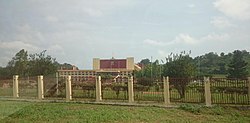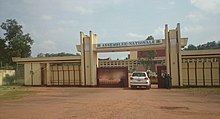| This article needs to be updated. Please help update this article to reflect recent events or newly available information. (March 2021) |
| National Assembly Assemblée nationale | |
|---|---|
 | |
| Type | |
| Type | Lower house |
| History | |
| Founded | December 12, 1960 (1960-12-12) |
| Leadership | |
| President of the Assembly | Simplice Sarandji, MCU since 5 May 2021 |
| Structure | |
| Seats | 140 members |
 | |
| Political groups | |
| Elections | |
| Last election | 27 December 2020 14 March 2021 (parliamentary re-run) 23 May 2021 (run-offs) |
| Meeting place | |
 | |
| Bangui | |
| Politics of the Central African Republic |
|---|
 |
| Constitution |
| Government |
| Parliament |
| Administrative divisions |
Elections
|
Foreign relations
|
|
|
The National Assembly is the lower house of the Parliament of the Central African Republic. Members are elected in single-member constituencies using the two-round (or run-off) system. Members serve five-year terms.
Legislative history
The first legislative arm was established in January 1947, called Representative Council of Ubangi-Shari. It was replaced by the 50-member Territorial Assembly of Ubangi-Shari in April 1952. Constituent Legislative Assembly was established in December 1958. The 50-member Legislative Assembly of the CAR (Assemblée législative de la RCA) began its functions in February 1959. It was replaced by National Assembly on 12 December 1960.
Jean-Bédel Bokassa dissolved the National Assembly in 1966 and imprisoned a number of its deputies. The constitution of Central African Empire in 1976 outlined the National Assembly with elections planned in 1979, however, Bokassa was overthrown before the elections took place.
The legislature of the Central African Republic was previously (at least as of 1990) a bicameral institution known as Congress, of which the National Assembly was the lower house; the upper house was called the Economic and Regional Council (French: Conseil Economique et Regional).
The National Assembly will be dissolved by Jan 11, 2014 and new legislative elections will be held, according to a ceasefire agreement signed between the government and the Seleka rebel coalition on Jan 11, 2013 in Libreville, Gabon. According to the agreement, a national unity government will be formed and a prime minister will be chosen from the opposition parties.
The National Assembly formed following elections held on 13 March and 8 May 2005, and had a total of 105 members.
The National Assembly is the lower house of the Parliament of the Central African Republic since the ratification of the Constitution of the Central African Republic on 27 March 2016.
Senate will be abolished upon the adoption of the 2023 constitution, and the National Assembly will be unicameral again.

See also
- History of the Central African Republic
- Politics of the Central African Republic
- List of national legislatures
- List of presidents of the National Assembly of the Central African Republic
References
- "Central African Republic". 5 July 2018.
- ^ Bradshaw, Richard; Fandos-Rius, Juan (2016). Historical dictionary of the Central African Republic. Lanham Boulder New York Toronto Plymouth, UK: Rowman & Littlefield. ISBN 9780810879928.
- "1990 CIA World Factbook". Central Intelligence Agency. Retrieved on July 18, 2012.
- "Central African Republic ceasefire signed". BBC News. 11 January 2013.
| Central African Republic articles | |||||
|---|---|---|---|---|---|
| History |  | ||||
| Geography | |||||
| Politics | |||||
| Economy | |||||
| Society |
| ||||
| Legislatures in Africa | |
|---|---|
| Sovereign states |
|
| Dependencies, autonomies, other territories |
|
| Italics indicate an unrecognised or partially recognised state. | |
4°23′36″N 18°33′46″E / 4.3933°N 18.5629°E / 4.3933; 18.5629
Categories: